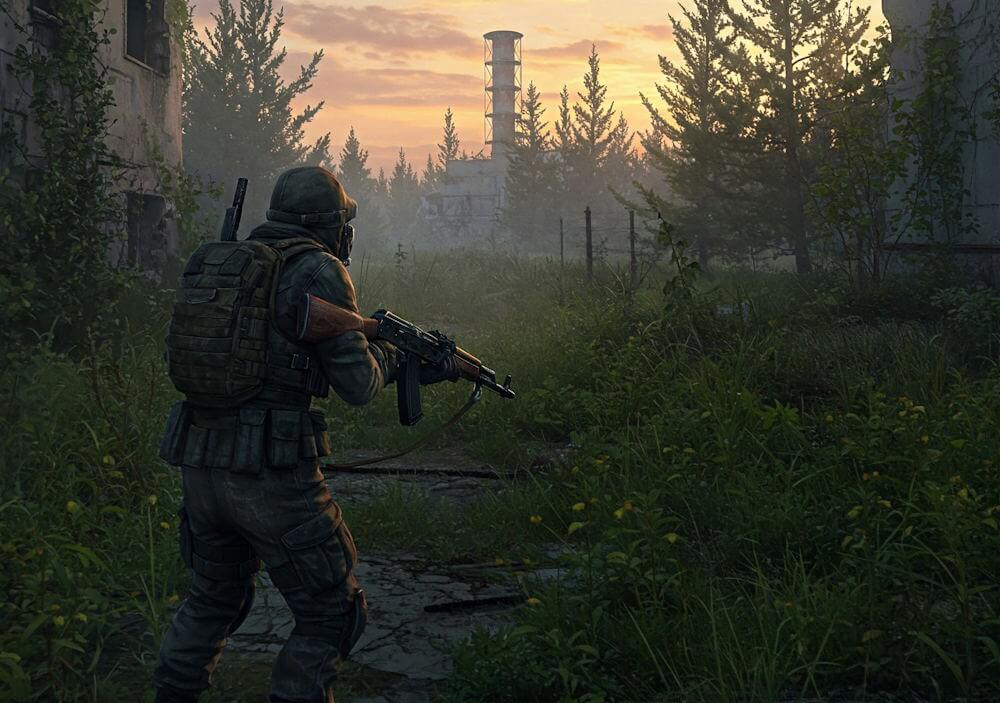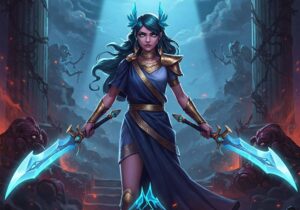The S.T.A.L.K.E.R. series debuted with “S.T.A.L.K.E.R.: Shadow of Chernobyl,” released in 2007, developed by the Ukrainian studio GSC Game World. Set in the Chernobyl Exclusion Zone, the series is heavily inspired by the novel “Roadside Picnic” by Arkady and Boris Strugatsky and Andrei Tarkovsky’s film “Stalker.” This unique blend of science fiction and horror immerses players in a post-apocalyptic environment where anomalies, mutated creatures, and rival factions create a complex tapestry of survival challenges. Players assume the role of stalkers—treasure hunters who navigate this treacherous terrain in search of artifacts and knowledge.
One of the key themes of the S.T.A.L.K.E.R. series is the exploration of humanity’s struggle against the unknown, as well as moral ambiguity in choices players must make. The narrative often emphasizes the psychological effects of life in such a hazardous environment, which is underscored by the game’s oppressive atmosphere and haunting soundtrack. Players experience a sense of isolation, which is further enhanced by the open-world style of gameplay allowing for nonlinear exploration and interaction. The incorporation of day-night cycles, weather changes, and dynamic AI influences both the immediate challenges and overarching gameplay experience.
Critically acclaimed, the S.T.A.L.K.E.R. series garnered a dedicated fanbase, earning a cult status often characterized by its blend of horror, storytelling, and open-ended exploration. Its influence can be seen in many subsequent first-person shooter and open-world games. By crafting a unique niche that combined immersive storytelling with survival-focused mechanics, the series has set a benchmark for future titles aiming to incorporate post-apocalyptic themes, narrative depth, and engaging gameplay dynamics. The lasting impact of S.T.A.L.K.E.R. on the gaming community exemplifies its significance in the evolution of video games today.
The Significance of S.T.A.L.K.E.R. 2
S.T.A.L.K.E.R. 2 holds substantial significance in the gaming landscape, especially when viewed through the lens of its predecessors. The original S.T.A.L.K.E.R. series, which began with “S.T.A.L.K.E.R.: Shadow of Chernobyl” released in 2007, has established a cult following due to its innovative blend of first-person shooter gameplay, survival horror elements, and open-world exploration steeped in the haunting atmosphere of the Chernobyl Exclusion Zone. This unique combination not only reshaped perceptions of survival games but also laid a powerful narrative foundation that has resonated with players for years.
The developers of S.T.A.L.K.E.R. 2 are committed to honoring this legacy by expanding on the themes and mechanics that defined the earlier titles. The new installment aims to enhance the narrative depth, providing players with a more interconnected and immersive storyline while ensuring that the core gameplay mechanics are refined and enriched. By leveraging advancements in technology, specifically graphics and AI, the sequel aspires to create an experience that resonates with both long-time fans of the series and newcomers.
Significantly, S.T.A.L.K.E.R. 2 seeks to explore new dimensions of player agency and environmental interaction. The idea of choice will play a fundamental role, allowing players to engage with the world and its inhabitants in meaningful ways. Such innovations will not only contribute to replayability but also deepen the emotional investment players have in the game’s universe. Furthermore, the game is poised to introduce fresh factions and characters, expanding the rich lore of the series while retaining the signature tone that defined its forebears.
The anticipation surrounding S.T.A.L.K.E.R. 2 is indicative of the community’s desire for this evolution, making it a pivotal moment in the ongoing legacy of the S.T.A.L.K.E.R. franchise. As it aims to balance the demands of modernization with the unwavering spirit of its predecessors, S.T.A.L.K.E.R. 2 is set to make a significant impact within the gaming industry, ensuring that the franchise continues to be a benchmark of excellence in both storytelling and gameplay.
Technological Advancements in S.T.A.L.K.E.R. 2
The gaming industry has witnessed tremendous evolution over the years, and the highly anticipated S.T.A.L.K.E.R. 2 is no exception. One of the most significant aspects driving this evolution is the incorporation of advanced technologies aimed at enhancing the overall gameplay experience. Among the numerous improvements, enhanced graphics stand out as a primary focus. Utilizing cutting-edge rendering techniques, S.T.A.L.K.E.R. 2 presents a visually stunning environment that offers players a visceral representation of the game’s post-apocalyptic world. The attention to detail in the graphics not only enhances the aesthetic value but also profoundly impacts the player’s sense of immersion within the game.
Another critical area of advancement is the use of sophisticated artificial intelligence (AI) systems. The AI behavior in S.T.A.L.K.E.R. 2 has been designed to create more realistic interactions and dynamic responses to player actions. This improvement allows NPCs (non-playable characters) to react more intelligently to the presence of the player, leading to encounters that feel organic and gratifying. The ability of AI to adapt and respond to various strategies employed by players enhances engagement, making each playthrough unique and more engaging.
Furthermore, upgrades in game physics contribute significantly to the realism of the experience. With improvements in physics engines, players will find that environmental interactions, such as bullet trajectories and destructible objects, behave more authentically. These enhancements not only impact combat scenarios but also facilitate innovative gameplay techniques, where players can exploit their surroundings to gain tactical advantages. As these technological advancements come together, they cultivate a rich, immersive experience that invites players to explore the deep, intricate world of S.T.A.L.K.E.R. 2, encouraging a deeper interaction with its narrative and challenges.
Expanding the Lore and World of the Zone
S.T.A.L.K.E.R. 2 is poised to significantly enhance the rich narrative tapestry of the Zone through a broader expansion of its lore. This sequel aims not only to build on the established backstory but also to introduce new factions, characters, and intricate story arcs that deepen player immersion. The developers have taken into consideration the community’s intense interest in the lore and the lore-heavy gameplay of the original titles. Consequently, S.T.A.L.K.E.R. 2 will offer players a more expansive universe to explore and interact with, thereby cultivating a more nuanced understanding of the Zone.
One way this is achieved is through the introduction of new factions with their own distinct motivations, ideologies, and conflicts. Each faction will not only add complexity but will also provide players with different perspectives on the mysteries of the Zone. Players will have the opportunity to align with or oppose these factions, influencing their gameplay experience and the overarching narrative. Such dynamics will allow for multiple paths and outcomes, thereby enhancing replayability.
Furthermore, S.T.A.L.K.E.R. 2 is set to introduce a diverse array of characters, each contributing to the world-building and narrative depth. These characters will fulfill various roles, serving as allies, antagonists, or neutral parties, and they will be intricately tied to the game’s multiple story arcs. Interactions with these characters promise to be more meaningful, allowing players to form relationships that can lead to impactful decisions that shape the storyline.
Engagement with the expanded lore will also come through various forms of gameplay, including quests, environmental storytelling, and collectible lore items. These elements will allow players to delve deeper into the mysteries of the Zone and piece together its history while navigating through its challenges. As a result, S.T.A.L.K.E.R. 2 seeks to offer a richer narrative experience, elevating the franchise to new heights and solidifying its place within the gaming landscape.
Gameplay Mechanics: What’s New and What’s Familiar
The gameplay mechanics in S.T.A.L.K.E.R. 2 reflect a careful blend of both innovation and nostalgia, as the developers aim to honor the franchise’s roots while introducing fresh elements. Combat remains a pivotal focus, maintaining the series’ signature blend of tactical shooting and survival. Players can expect to engage in intense firefights, leveraging both firearms and stealth techniques similar to prior titles. Familiar weapons and gear including iconic firearms will return, yet they are complemented by an expanded arsenal featuring advanced customization options that allow players to tailor their loadouts to suit their unique playstyles.
Exploration within the Zone continues to be a core element, with vast, open-world environments to traverse that echo the original games. However, S.T.A.L.K.E.R. 2 invites players to discover new locations and secrets with enhanced graphical fidelity. The incorporation of dynamic weather systems and day-night cycles instills a genuine sense of immersion, affecting the behavior of NPCs, creatures, and the player alike. This incorporation of new exploration mechanics aims to elevate the overall experience, encouraging thorough investigation while enhancing the unpredictability that fans have come to appreciate.
As for survival mechanics, the franchise retains its focus on resource management, with supplies and environmental factors playing critical roles in a player’s journey. Health, stamina, and the effects of radiation are features familiar to long-time fans, yet S.T.A.L.K.E.R. 2 introduces new survival elements, including advanced crafting systems and environmental interactions that require players to adapt their strategies. Gathering resources will not only be essential for survival but will also open avenues for character development, allowing players to evolve their skills and attributes in response to the challenges they face. By striking a balance between the beloved aspects of previous S.T.A.L.K.E.R. titles and novel gameplay elements, S.T.A.L.K.E.R. 2 aims to deliver a rich and engaging player experience.
Player Choices and Consequences
In the realm of video gaming, player choice serves as a cornerstone of engagement, particularly in the S.T.A.L.K.E.R. series. S.T.A.L.K.E.R. 2 continues this tradition by emphasizing the importance of player agency. Each choice players make reverberates throughout the storyline, shaping both the immediate narrative and the broader game world. Decisions in S.T.A.L.K.E.R. 2 are not merely superficial; they have consequential impacts on character relationships, faction dynamics, and the ultimate outcomes players experience.
The mechanics of decision-making in S.T.A.L.K.E.R. 2 reflect the series’ unwavering commitment to immersive storytelling. As players navigate the perilous landscapes of the Zone, they are confronted with moral dilemmas that require careful consideration. For instance, players may choose to assist one faction at the expense of another, impacting not only their standing within the game but also how the world evolves around them. This intricate web of choices reinforces the notion that every action has repercussions, thereby enhancing player investment in the narrative.
Players familiar with the original S.T.A.L.K.E.R. titles will recognize this emphasis on consequences as a hallmark of the franchise. The narrative depth achieved through player decisions fosters a personal connection to the storyline, as every choice echoes the themes of survival, betrayal, and loyalty inherent to the game. By exploring varied paths, players can experience multiple outcomes, encouraging repeat playthroughs to uncover all possible narrative threads and their corresponding consequences.
Moreover, the integration of decision-making elements enhances the overall gameplay experience, allowing for tailored narratives that resonate with individual players. S.T.A.L.K.E.R. 2’s approach to player choices not only honors the legacy of its predecessors but also establishes a framework for future developments within the genre. As players journey through this expansive world, they are reminded that their decisions shape both their fate and the environment surrounding them.
Community and Modding Legacy
The S.T.A.L.K.E.R. series has become a hallmark of the gaming world, not merely due to its engaging storytelling or immersive environment, but significantly because of the vibrant modding community that has emerged around it. Since the release of the original S.T.A.L.K.E.R.: Shadow of Chernobyl, passionate players have taken it upon themselves to create modifications that enhance gameplay, improve graphics, and even introduce completely new storylines. This community-driven content has profoundly shaped the player’s experience and fostered a sense of shared ownership of the S.T.A.L.K.E.R. universe.
Modifications have ranged widely in scope and ambition. Some focus on minor quality-of-life tweaks, while others present expansive new maps, quests, and game mechanics that challenge the very nature of the original gameplay. Notable mods, such as the “Call of Chernobyl” and “Anomaly,” have gained significant recognition, establishing themselves as almost alternative versions of the S.T.A.L.K.E.R. experience. This diversity in modding not only evidences the creativity of the community but also raises the expectation that S.T.A.L.K.E.R. 2 will build upon these elements, incorporating user-generated content into its framework.
The developers have recognized the significance of this modding culture; as such, they have expressed intentions to support and encourage the creation of modifications in the upcoming S.T.A.L.K.E.R. 2. By providing robust modding tools and resources, developers can empower fans to innovate and expand the gameplay beyond the original vision. This collaborative relationship between the developers and the modding community is essential for keeping the legacy of S.T.A.L.K.E.R. alive and vibrant. Ultimately, as S.T.A.L.K.E.R. 2 makes its debut, honoring this legacy and integrating modding capabilities may pave the way for an enriched gaming experience that resonates with both new players and long-time fans alike.
Anticipation and Expectations from Fans
As the release date for S.T.A.L.K.E.R. 2 draws nearer, anticipation among the fanbase is palpable. The cult status of the previous S.T.A.L.K.E.R. titles has created a unique set of expectations. Players have invested considerable time in navigating the harsh realities of the Zone, fostering a community rich in theories and aspirations for the sequel. The feedback from gamers has centered around a desire for deeper storytelling, expanded gameplay mechanics, and fidelity to the atmospheric elements that defined the original titles.
The S.T.A.L.K.E.R. series is renowned for its immersive experiences and complex narratives that blend horror, sci-fi, and survival elements. Fans hope to see these attributes evolve in the upcoming installment, making the anticipated game more enriched and engaging. Many have speculated about the potential for open-world exploration, dynamic weather systems, and enhanced AI interactions, which could significantly elevate the gaming experience. This anticipation is not just a wish list but comes from a place of genuine investment in a franchise that has cultivated loyalty through compelling storytelling and innovative gameplay.
However, the developers face formidable challenges in living up to these expectations. The evolution of gaming technology and the need to appeal to both longtime fans and a new audience can create a precarious balance to strike. The weight of high expectations could lead to scrutiny and disappointment if the final product does not meet the hoped-for advancements or remains too faithful to past designs without innovation. This backdrop of anticipation underscores the importance of cautious optimism within the community. Ultimately, it is the hope that S.T.A.L.K.E.R. 2 will not only honor its legacy but also carve its own path, solidifying its place in the hearts of gamers for years to come.
Conclusion: The Legacy Continues
The journey of S.T.A.L.K.E.R. 2 represents a unique convergence of legacy and innovation, reflecting the franchise’s rich history while embracing modern advancements in game design. From its inception, the S.T.A.L.K.E.R. series has captivated players with its immersive world, intricate narratives, and the haunting atmosphere of the Chernobyl Exclusion Zone. The evolution into S.T.A.L.K.E.R. 2 illustrates not only a commitment to preserving the essence of what made the original games successful but also an ambition to explore new frontiers in storytelling and gameplay mechanics.
In this new installment, players can expect a seamless integration of elements that define the S.T.A.L.K.E.R. experience, such as dynamic environments, psychological horror, and a rich lore steeped in post-apocalyptic realism. The dedication to honoring the series’ history is evident in the attention to detail and the nuanced connections with past titles. However, the developers are also pushing boundaries by incorporating advanced graphics, enhanced AI, and improved multiplayer capabilities, making the gameplay more engaging and interactive than ever before.
This blend of old and new is what positions S.T.A.L.K.E.R. 2 as a bridge between the beloved legacy and the future of video gaming. It paves the way for new generations of players to discover the franchise while also catering to the nostalgia of long-time fans. As we look ahead, the ongoing commitment to innovation, while respecting the roots of the series, instills a sense of optimism for its future. The legacy of S.T.A.L.K.E.R. continues to thrive, promising exciting developments that will keep players on the edges of their seats as they navigate the eerie yet compelling world of the Zone.




